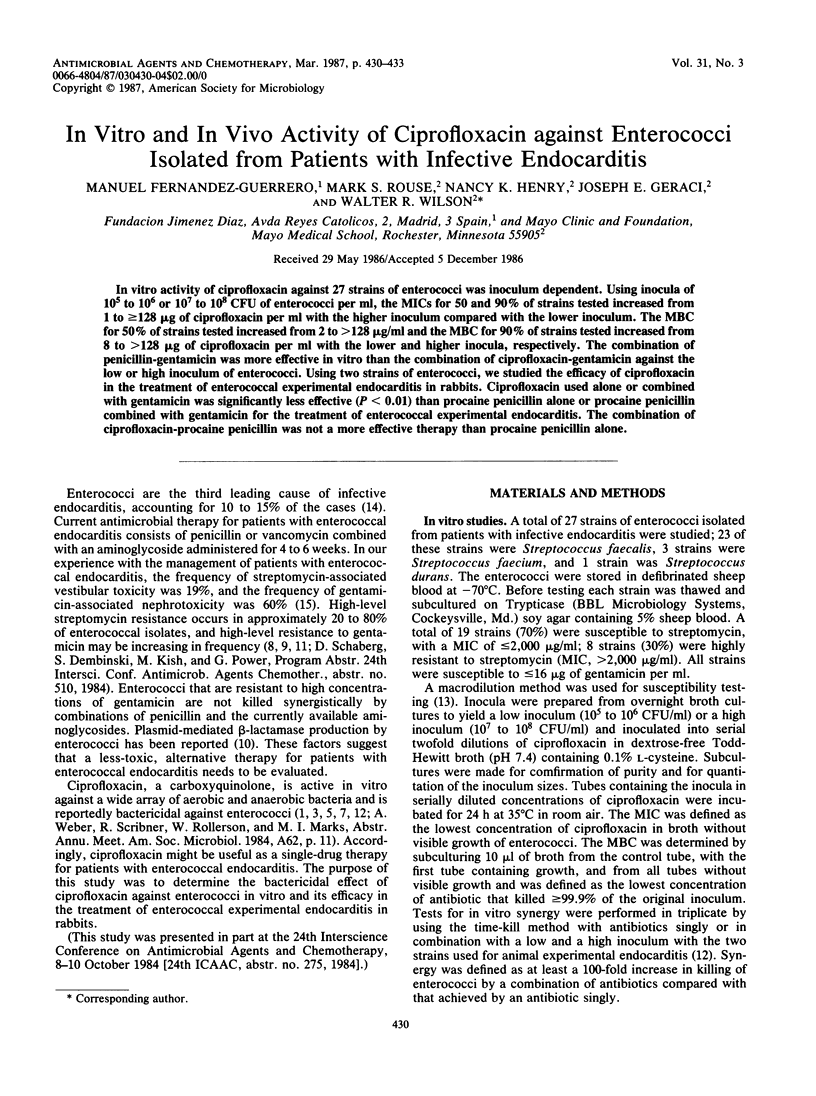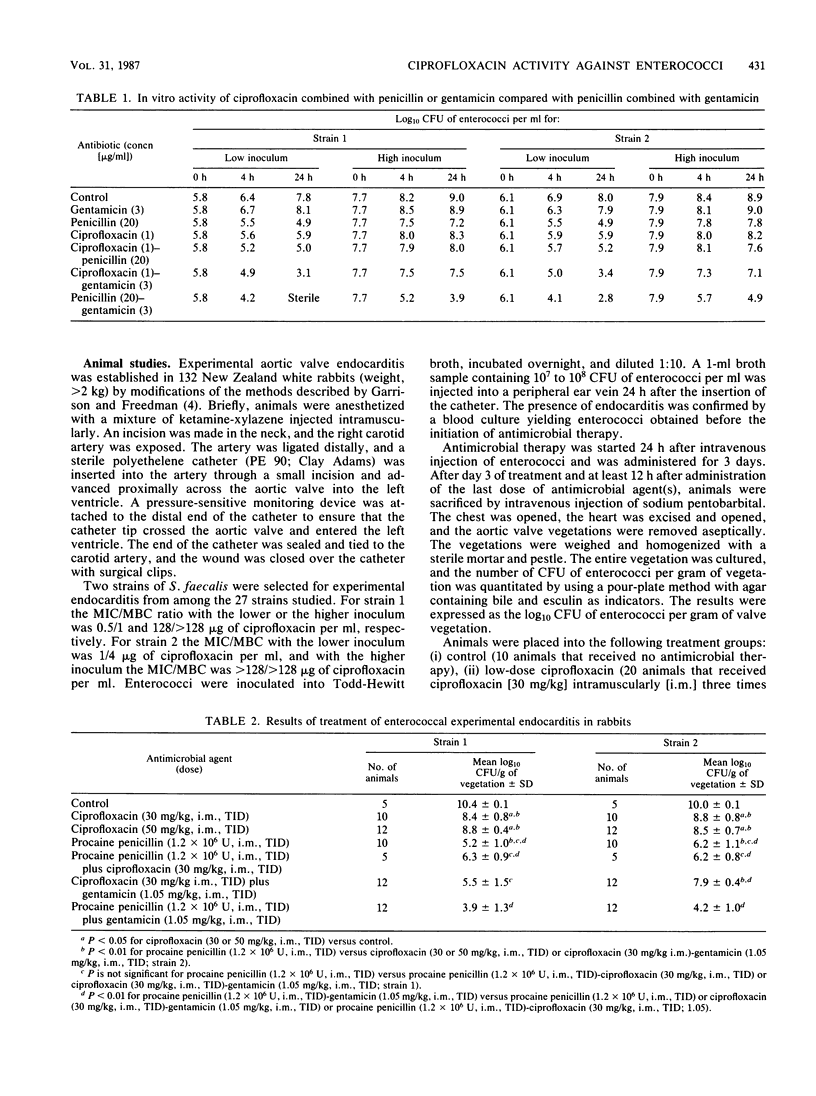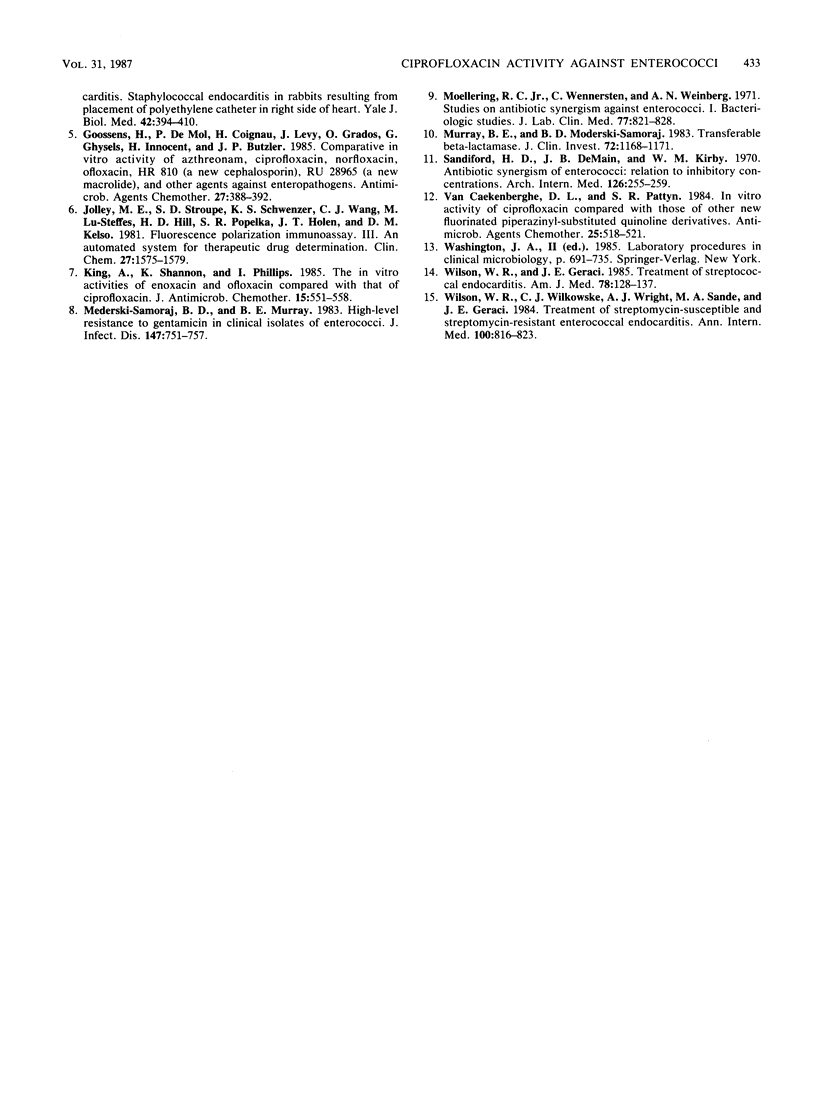Abstract
In vitro activity of ciprofloxacin against 27 strains of enterococci was inoculum dependent. Using inocula of 10(5) to 10(6) or 10(7) to 10(8) CFU of enterococci per ml, the MICs for 50 and 90% of strains tested increased from 1 to greater than or equal to 128 micrograms of ciprofloxacin per ml with the higher inoculum compared with the lower inoculum. The MBC for 50% of strains tested increased from 2 to greater than 128 micrograms/ml and the MBC for 90% of strains tested increased from 8 to greater than 128 micrograms of ciprofloxacin per ml with the lower and higher inocula, respectively. The combination of penicillin-gentamicin was more effective in vitro than the combination of ciprofloxacin-gentamicin against the low or high inoculum of enterococci. Using two strains of enterococci, we studied the efficacy of ciprofloxacin in the treatment of enterococcal experimental endocarditis in rabbits. Ciprofloxacin used alone or combined with gentamicin was significantly less effective (P less than 0.01) than procaine penicillin alone or procaine penicillin combined with gentamicin for the treatment of enterococcal experimental endocarditis. The combination of ciprofloxacin-procaine penicillin was not a more effective therapy than procaine penicillin alone.
Full text
PDF



Selected References
These references are in PubMed. This may not be the complete list of references from this article.
- Bauernfeind A., Petermüller C. In vitro activity of ciprofloxacin, norfloxacin and nalidixic acid. Eur J Clin Microbiol. 1983 Apr;2(2):111–115. doi: 10.1007/BF02001575. [DOI] [PubMed] [Google Scholar]
- Forsgren A. Comparative in vitro activity of three new quinolone antibiotics against recent clinical isolates. Scand J Infect Dis. 1985;17(1):91–94. doi: 10.3109/00365548509070426. [DOI] [PubMed] [Google Scholar]
- Garrison P. K., Freedman L. R. Experimental endocarditis I. Staphylococcal endocarditis in rabbits resulting from placement of a polyethylene catheter in the right side of the heart. Yale J Biol Med. 1970 Jun;42(6):394–410. [PMC free article] [PubMed] [Google Scholar]
- Goossens H., De Mol P., Coignau H., Levy J., Grados O., Ghysels G., Innocent H., Butzler J. P. Comparative in vitro activities of aztreonam, ciprofloxacin, norfloxacin, ofloxacin, HR 810 (a new cephalosporin), RU28965 (a new macrolide), and other agents against enteropathogens. Antimicrob Agents Chemother. 1985 Mar;27(3):388–392. doi: 10.1128/aac.27.3.388. [DOI] [PMC free article] [PubMed] [Google Scholar]
- Jolley M. E., Stroupe S. D., Schwenzer K. S., Wang C. J., Lu-Steffes M., Hill H. D., Popelka S. R., Holen J. T., Kelso D. M. Fluorescence polarization immunoassay. iii. an automated system for therapeutic drug determination. Clin Chem. 1981 Sep;27(9):1575–1579. [PubMed] [Google Scholar]
- King A., Shannon K., Phillips I. The in-vitro activities of enoxacin and ofloxacin compared with that of ciprofloxacin. J Antimicrob Chemother. 1985 May;15(5):551–558. doi: 10.1093/jac/15.5.551. [DOI] [PubMed] [Google Scholar]
- Mederski-Samoraj B. D., Murray B. E. High-level resistance to gentamicin in clinical isolates of enterococci. J Infect Dis. 1983 Apr;147(4):751–757. doi: 10.1093/infdis/147.4.751. [DOI] [PubMed] [Google Scholar]
- Moellering R. C., Jr, Wennersten C., Weinberg A. N. Studies on antibiotic synergism against enterococci. I. Bacteriologic studies. J Lab Clin Med. 1971 May;77(5):821–828. [PubMed] [Google Scholar]
- Murray B. E., Mederski-Samaroj B. Transferable beta-lactamase. A new mechanism for in vitro penicillin resistance in Streptococcus faecalis. J Clin Invest. 1983 Sep;72(3):1168–1171. doi: 10.1172/JCI111042. [DOI] [PMC free article] [PubMed] [Google Scholar]
- Standiford H. D., De Maine J. B., Kirby W. M. Antibiotic synergism of enterococci. Relation to inhibitory concentrations. Arch Intern Med. 1970 Aug;126(2):255–259. [PubMed] [Google Scholar]
- Van Caekenberghe D. L., Pattyn S. R. In vitro activity of ciprofloxacin compared with those of other new fluorinated piperazinyl-substituted quinoline derivatives. Antimicrob Agents Chemother. 1984 Apr;25(4):518–521. doi: 10.1128/aac.25.4.518. [DOI] [PMC free article] [PubMed] [Google Scholar]
- Wilson W. R., Geraci J. E. Treatment of streptococcal infective endocarditis. Am J Med. 1985 Jun 28;78(6B):128–137. doi: 10.1016/0002-9343(85)90375-4. [DOI] [PubMed] [Google Scholar]
- Wilson W. R., Wilkowske C. J., Wright A. J., Sande M. A., Geraci J. E. Treatment of streptomycin-susceptible and streptomycin-resistant enterococcal endocarditis. Ann Intern Med. 1984 Jun;100(6):816–823. doi: 10.7326/0003-4819-100-6-816. [DOI] [PubMed] [Google Scholar]


